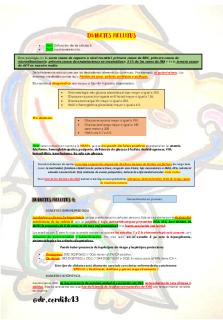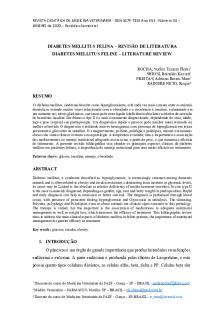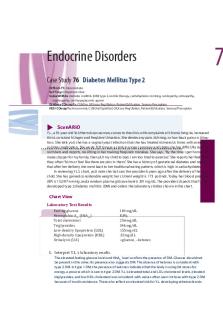Case Study- Diabetes Mellitus 2021/2022 PDF

| Title | Case Study- Diabetes Mellitus 2021/2022 |
|---|---|
| Author | daljit thind |
| Course | Nursing LVN |
| Institution | Unitek College |
| Pages | 4 |
| File Size | 169.5 KB |
| File Type | |
| Total Downloads | 81 |
| Total Views | 156 |
Summary
Case study on diabetes mellitus which will help student understand the concepts of diabetes in depth and get familiar er with the concept...
Description
Endocrine Disorders Case Study 76 Diabetes Mellitus Type 2 Difficulty: Intermediate Setting: Outpatient clinic Index Words: diabetes mellitus (DM) type 2, insulin therapy, carbohydrate counting, neuropathy, retinopathy, nephropathy, oral hypoglycemic agents Giddens Concepts: Culture, Glucose Regulation, Patient Education, Sensory Perception HESI Concepts: Assessment, Cultural/Spiritual, Glucose Regulation, Patient Education, Sensory/Perception
u Scenario Y.L., a 34-year-old Southern Asian woman, comes to the clinic with complaints of chronic fatigue, increased thirst, constant hunger, and frequent urination. She denies any pain, burning, or low-back pain on urination. She tells you she has a vaginal yeast infection that she has treated numerous times with over-thecounter medication. She works full time as a clerk in a loan company and states she has difficulty reading numbers and reports, resulting in her making frequent mistakes. She says, “By the time I get home and make supper for my family, then put my child to bed, I am too tired to exercise.” She reports her feet hurt; they often “burn or feel like there are pins in them.” She has a history of gestational diabetes and reports that after her delivery she went back to her traditional eating pattern, which is high in carbohydrates. In reviewing Y.L.'s chart, you note she last saw the provider 6years ago after the delivery of her last child. She has gained considerable weight; her current weight is 173 pounds. Today her blood pressure (BP) is 152/97 mm Hg, and a random plasma glucose level is 291 mg/dL. The provider suspects that Y.L. has developed type 2 diabetes mellitus (DM) and orders the laboratory studies shown in the chart.
Chart View Laboratory Test Results Fasting glucose Hemoglobin A1c (HbA1c) Total cholesterol Triglycerides Low-density lipoprotein (LDL) High-density lipoprotein (HDL) Urinalysis (UA)
184 mg/dL 8.8% 256 mg/dL 346 mg/dL 155 mg/dL 32 mg/dL +glucose, −ketones
1. Interpret Y.L.'s laboratory results. The elevated fasting glucose level and HbA1c level confirm the presence of DM. Glucose should not be present in the urine; its presence also suggests DM. The absence of ketones is consistent with type 2 DM. In type 1 DM, the presence of ketones indicates that the body is using fat stores for energy, a process which is rare in type 2 DM. Y.L.'s elevated total and LDL cholesterol levels, elevated triglycerides, and low HDL cholesterol are consistent with values often seen in those with type 2 DM because of insulin resistance. These also reflect an elevated risk for Y.L. developing atherosclerosis.
7
Part 1 MEDICal-SurGICal CaSES
2. Identify the three methods used to diagnose DM. • HbA1c of 6.5% or higher. • Fasting plasma glucose level of 126 mg/dL (7.0 mmol/L) or higher. Fasting is defined as having had no caloric intake for at least 8 hours before the blood is drawn. • Two-hour plasma glucose level of 200 mg/dL (11.1 mmol/L) or higher during an oral glucose tolerance test (OGTT), using a glucose load of 75 g. • Random, or casual, plasma glucose over 200 mg/dL plus symptoms of DM, such as polydipsia, polyphagia, polyuria, and unexplained weight loss. Casual is defined as any time of day without regard to meals.
7 Endocrine Disorders
3. Describe the functions of insulin. Insulin facilitates the entry into the cell of glucose for an energy source and amino acids for protein synthesis. It stimulates glycogenesis (conversion of glucose to glycogen to be stored in the liver and muscle cells), enhances lipogenesis, and prevents the mobilization or breakdown of fats for energy that would result in ketosis. Insulin inhibits glycogenolysis (conversion of glycogen to glucose from the liver and muscle cells) and gluconeogenesis (the formation of glucose from noncarbohydrates such as amino acids).
4. Describe the major pathophysiologic difference between type 1 and type 2 DM. The presence of endogenous insulin is the major pathophysiologic distinction between type 1 and type 2 DM. In type 2 DM, the primary issue is insulin resistance in the tissues and the pancreas usually continues to produce some insulin. However, the insulin that is produced is either insufficient for the needs of the body and/or is poorly used by the tissues, which are insulin resistant. In type 1 DM, there is an absolute deficiency of endogenous insulin.
5. Name six risk factors for type 2 DM. Place a star or asterisk next to those that Y.L. exhibits. Elevated BMI* Sedentary lifestyle* First degree relative with type 2 diabetes Ethnicity (African American, Hispanic, Native American, Asian American, Pacific Islander)* Hypertension (≥140/90 mm Hg or on therapy)* Polycystic ovarian syndrome Delivered a baby over 9 pounds or has a history of gestational diabetes* HDL-C 250 mg/dL * Impaired fasting glucose or impaired glucose intolerance
CaSE StuDy ProGrESS Y.L. is diagnosed with type 2 DM. The provider starts her on metformin (Glucophage) 500 mg and glipizide (Glucotrol) 5 mg orally each day at breakfast and atorvastatin (Lipitor) 20 mg orally at bedtime. She is referred to the dietitian for instructions on starting a 1200-calorie diet using an exchange system to facilitate weight loss and lower blood glucose, cholesterol, and triglyceride levels. You are to provide education regarding pharmacotherapy and exercise.
6. How can you incorporate Y.W.'s cultural preferences as you develop her education plan? So you can interpret the context of her culture in her lifestyle, you need to assess several factors. What is her primary language? She may need written information in another language. What is her understanding of diabetes? In some Asian cultures, it is believed that developing diabetes is fate or the result of spiritual failure. How does her culture affect her lifestyle? What is her religion? She may fast periodically, causing swings in glucose levels, and may wish to incorporate Eastern medicine practices into her DM care What are her eating habits? The diet may be high in carbohydrates such
Part 1 MEDICal-SurGICal CaSES
CASE STuDY 76
7. What is the rationale for starting Y.L. on metformin (Glucophage) and glipizide (Glucotrol)? Combination drug therapy is used with drugs with different mechanisms of action. An effective combination is the use of metformin plus a sulfonylurea. Metformin, a biguanide, decreases glucose production by the liver, decreases intestinal absorption of glucose, increases the number of insulin receptors and improves their sensitivity. This increases peripheral glucose uptake and use and decreases hepatic production of triglycerides and cholesterol. Because it can cause moderate weight loss, Metformin is useful in those who are also overweight. Glipizide, a second-generation sulfonylurea, stimulates the release of insulin from the pancreatic islets.
8. Outline the teaching you need to provide to Y.L. regarding oral hypoglycemic therapy. • For each drug, review the name, action, dose, storage, adverse reactions, and side effects. Review when to take the drugs. She should eat the prescribed diet and take the first doses with breakfast. Missing or delaying meals increases the risk of swings in glucose levels. • Because a hypoglycemic reaction can occur with glipizide, teach her the symptoms of hypoglycemic reaction (headache, nervousness, sweating, tremors, and rapid pulse), how to treat a reaction, and ways to decrease the chance of a reaction (avoiding alcohol, sick day rules). • Teach her the symptoms of hyperglycemia (thirst, increased urine output, sweet fruity breath odor) and what to do if hyperglycemia occurs. • Advise Y.L. to obtain a medical alert card, tag, or bracelet indicating type 2 DM and carry a card in her wallet outlining her medication regimen. • She should avoid OTC medications unless approved by the prescriber.
9. What benefits should Y.L. receive from encouragement to exercise? Exercise helps control type 2 DM by improving the action of a person's naturally produced insulin through increasing the number of insulin receptor sites. Muscle activity also improves glucose uptake for energy and improves circulation. Other potential benefits of exercise include reduced weight and body fat, improved strength and work capacity, improved cardiovascular function, decreased risk for coronary artery disease (CAD) by lowering cholesterol and triglycerides and increasing HDL, especially in the presence of weight loss, control of HTN, and improved well-being and quality of life.
CaSE StuDy ProGrESS Y.L. comments, “I've heard many people with diabetes lose their toes or even their feet.” You take this opportunity to teach her about neuropathy and foot care.
10. Which of the symptoms that Y.L. reported today led you to believe she has some form of neuropathy? Y.L. stated her feet hurt—that they “burn or feel like there are pins in them.”
11. What other findings in Y.L.'s history place her at increased risk for developing neuropathy? • HTN: BP 152/97 mm Hg • Elevated cholesterol levels and hypertriglycerides
12. What would you teach Y.L. about neuropathy? DM is a common cause of nerve damage or neuropathy. It can manifest as pain, tingling, pins and needles, or numbness. High glucose levels over time damage nerves and alter how they send signals. Treatment of neuropathy is aimed at symptom relief and/or prevention of progression. It is important to control glucose levels, to exercise, and to be diligent about good foot care.
Part 1 MEDICal-SurGICal CaSES
7 Endocrine Disorders
13. Because Y.L. has symptoms of neuropathy, placing her at risk for foot complications, you realize you need to instruct her on proper foot care. Outline what you will include when teaching her about proper diabetic foot care. • Inspect all surfaces of the feet daily for cuts, blisters, swelling, and red, tender areas. This might require using a mirror or having a caregiver inspect the feet. • Wash feet daily and dry feet thoroughly. Avoid hot water. • Wear properly fitting shoes, and inspect the shoes daily for cracks, pebbles, nails, and loose linings. Avoid high-heeled shoes and shoes with pointed toes. • Avoid walking barefoot or in stocking feet. Do not wear shoes without socks, and do wear clean, absorbent (cotton or wool) socks or stockings that are unmended. Avoid temperature extremes. Wear socks for warmth and avoid heating pads or hot water bottles on the feet. • Check the temperature of bath or shower water to avoid burns. • Moisturize skin daily. Do not use lotion between toes. Avoid lotions with alcohol because they facilitate dryness. • Cut toenails straight across and file sharp edges to match the contour of the toe. Patients with peripheral neuropathy, peripheral artery disease, or poor vision should not trim their own toenails. Refer the patient to a podiatrist as needed. • Avoid using chemicals, razors, and sharp instruments to self-treat corns, calluses, or ingrown toenails. See a podiatrist for these problems. • Report and seek prompt medical attention for problems that do not resolve in a matter of days; do not wait for weeks.
14. What monitoring will Y.L. need regarding nephropathy and retinopathy? Y.L. would need to be monitored for changes in renal function, indicated by increases in blood urea nitrogen (BUN; more than 20 mg/dL), creatinine (more than 1.5 mg/dL), proteinuria (protein more than 8 mg/dL in a random sample of urine), and microalbuminuria. Y.L. should have regular dilated eye examinations by an ophthalmologist or a specially trained optometrist, beginning now and on an annual basis hereafter....
Similar Free PDFs

Diabetes Mellitus Case Study
- 15 Pages

Diabetes Mellitus Case Study v1
- 3 Pages

Diabetes mellitus
- 15 Pages

Diabetes Mellitus
- 3 Pages

Diagnosis Diabetes Mellitus
- 4 Pages

Pathway of Diabetes Mellitus
- 4 Pages

makalah diabetes mellitus
- 10 Pages

DIABETES MELLITUS RESÚMEN CLAVE
- 3 Pages

PAE diabetes mellitus
- 16 Pages

Diabetes Mellitus em gatos
- 8 Pages

Ensayo diabetes mellitus
- 3 Pages
Popular Institutions
- Tinajero National High School - Annex
- Politeknik Caltex Riau
- Yokohama City University
- SGT University
- University of Al-Qadisiyah
- Divine Word College of Vigan
- Techniek College Rotterdam
- Universidade de Santiago
- Universiti Teknologi MARA Cawangan Johor Kampus Pasir Gudang
- Poltekkes Kemenkes Yogyakarta
- Baguio City National High School
- Colegio san marcos
- preparatoria uno
- Centro de Bachillerato Tecnológico Industrial y de Servicios No. 107
- Dalian Maritime University
- Quang Trung Secondary School
- Colegio Tecnológico en Informática
- Corporación Regional de Educación Superior
- Grupo CEDVA
- Dar Al Uloom University
- Centro de Estudios Preuniversitarios de la Universidad Nacional de Ingeniería
- 上智大学
- Aakash International School, Nuna Majara
- San Felipe Neri Catholic School
- Kang Chiao International School - New Taipei City
- Misamis Occidental National High School
- Institución Educativa Escuela Normal Juan Ladrilleros
- Kolehiyo ng Pantukan
- Batanes State College
- Instituto Continental
- Sekolah Menengah Kejuruan Kesehatan Kaltara (Tarakan)
- Colegio de La Inmaculada Concepcion - Cebu




